Small Modular Reactor Market Research, 2032
The global small modular reactor market was valued at $5.8 billion in 2022, and is projected to reach $13.4 billion by 2032, growing at a CAGR of 8.7% from 2023 to 2032.
Report Key Highlighters:
- The small modular reactor market analysis study covers 20 countries. The research includes a segment analysis of each country in terms of value ($million) for the projected period 2023-2032.
- The study incorporated research methodology aims to present a comprehensive outlook on global markets and aid key stakeholders & players in making well-informed decisions to accomplish their ambitious growth goals.
- Over 1,500 product literatures, industry statements, annual reports, and other comparable materials from major small modular reactor industry participants were reviewed to gain a better understanding of the market.
- The small modular reactor market is fragmented, with several players including Brookfield, Fluor Corporation, General Atomics, General Electric, Holtec International, Mitsubishi Heavy Industries, Rolls Royce Plc, TerraPower LLC, Terrestrial Energy, Ultra Safe Nuclear, Moltex Energy, NuScale Power LLC, Westinghouse Electric Company, and X Energy LLC. Also tracked key strategies such as acquisitions, product launches, developments, partnership, mergers, expansion etc. of the players operating in the small modular reactor industry.
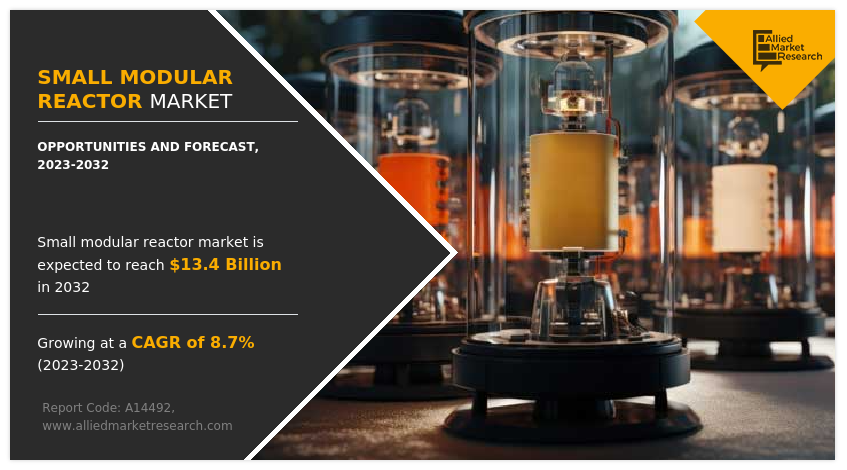
Small modular reactors (SMRs) are constructed in a factory using module fabrication to achieve shorter construction times as compared to traditional nuclear reactors. Being small in size, modular reactors offer power output in the range of 300 to 700 MW. A small modular reactor is designed for 300 MW equivalent or less of power output. The reactor is still in its design phase. Only three SMRs are currently in their regulatory phase, namely, NuScale’s Power Module, GE-Hitachi’s BWRX 300, and Terrestrial Energy’s Integral Molten Salt Reactor. SMRs can be made to operate underground or as a floating nuclear power unit. They are primarily used for electricity generation; however, they are also used in seawater desalination and process heating. Their designs promise affordable, safe, viable, and non-greenhouse gas-emitting energy.
Rise in demand for remote power generation, advantages offered by modular reactors, and increase in demand for clean energy are some of the major factors that drive the development of modular reactors. Modular reactors can be used in remote locations where major power grids cannot be used. This includes land as well as marine applications. In marine applications, small modular reactors help in meeting the energy needs of submarines, ships, and other water units. Moreover, modularized construction of modular reactors requires less time for construction. The size of SMRs facilitates modularized construction in factories and direct assembling on operating sites, and in addition, helps in the convenient transportation of reactors to the site.
Furthermore, the construction and commissioning of a nuclear power plant requires up to 11–12 years, as compared to 3–4 years in the case of a modular reactor. SMRs rely more on passive systems, thereby increasing safety. Furthermore, there is a global requirement for clean energy to reduce fossil fuel dependency and lower greenhouse emissions. As a result, more focus is put on wind, solar, and nuclear energy. This factor is expected to positively impact the global small modular reactor market during the forecast period.
However, more focus is directed toward renewable sources such as wind and solar power. One of the prime reasons behind preferring solar or wind energy over nuclear is safety. In addition, negative sentiments related to nuclear power plants is expected to hinder the small modular reactor market growth during the forecast period. Countries such as Germany are taking less interest in nuclear power and more focus is put on wind and solar electricity.
Global efforts towards decarbonization in the energy sector offer lucrative opportunities for the global small modular reactor market during the forecast period. Expanding the role of nuclear energy in electricity production through a combination of advanced reactors and thermal energy storage helps in more emission control.
The small modular reactor market scope is segmented into reactor type, connectivity, deployment, power rating, location, application, and region. On the basis of reactor type, the market is segmented into heavy water reactor (HWR), light water reactor (LWR), fast neutron reactor (FNR), and others. On the basis of connectivity, the market is bifurcated into off-grid and grid-connected. On the basis of deployment, the market is bifurcated into single module power plant and multi module power plant. On the basis of power rating, the market is segmented into up to 100 MW, 101 to 200 MW, and 201 to 300 MW.
On the basis of location, the market is bifurcated into land and marine. By application, the market is segmented into desalination, power generation, and industrial. Region-wise, the small modular reactor market is analyzed across North America, Europe, Asia-Pacific, and LAMEA.
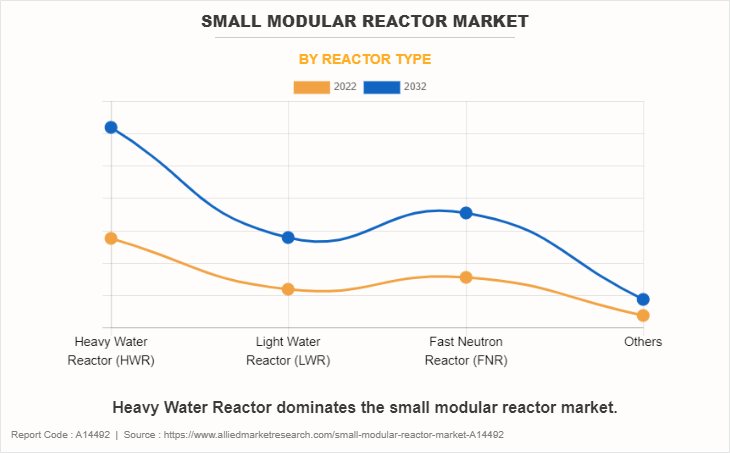
Based on reactor type, the heavy water reactor segment held the highest market share in 2022, accounting for nearly half of the global small modular reactor market revenue, and is estimated to maintain its leadership status throughout the forecast period.
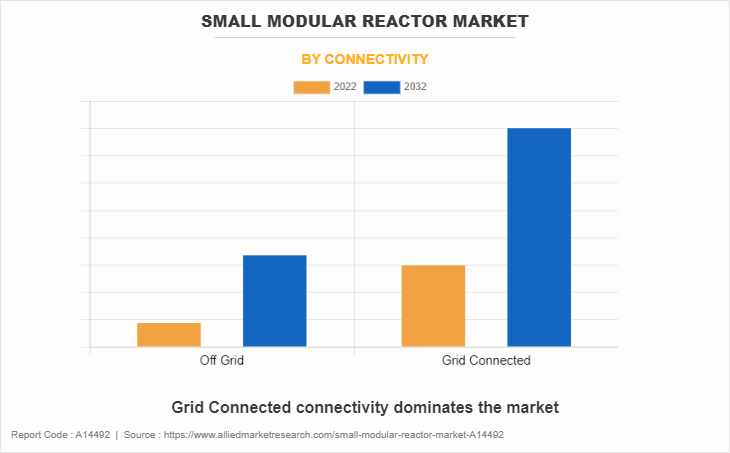
Based on connectivity, grid connected segment held the highest market share in 2022, accounting for more than two-thirds of the global small modular reactor market revenue, and is estimated to maintain its leadership status throughout the forecast period.
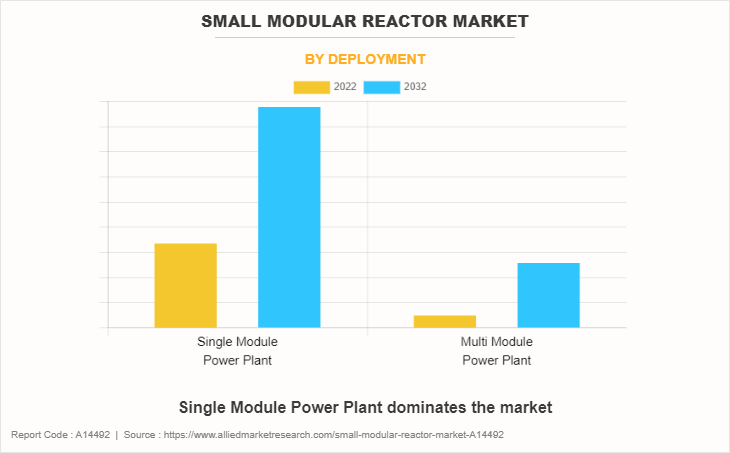
Based on the deployment, the single module power plant segment held the highest market share in 2022, accounting for nearly three-fourths of the global small modular reactor market revenue, and is estimated to maintain its leadership status throughout the forecast period.
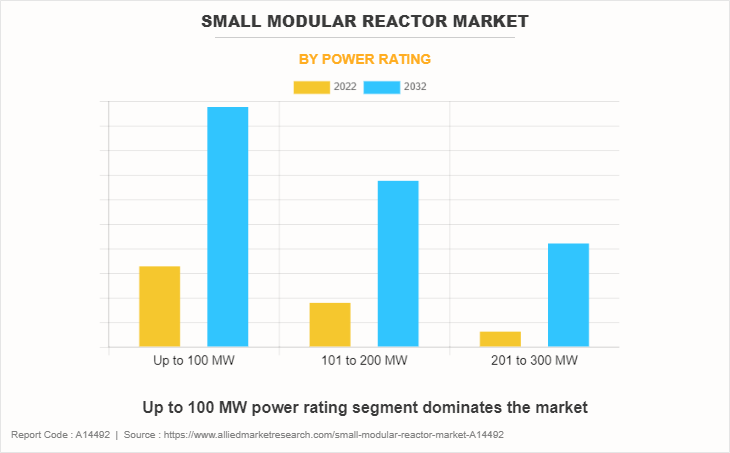
Based on the power rating, Up to 100 MW held the highest market share in 2022, accounting for nearly half of the global small modular reactor market size, and are estimated to maintain their leadership status throughout the forecast period.
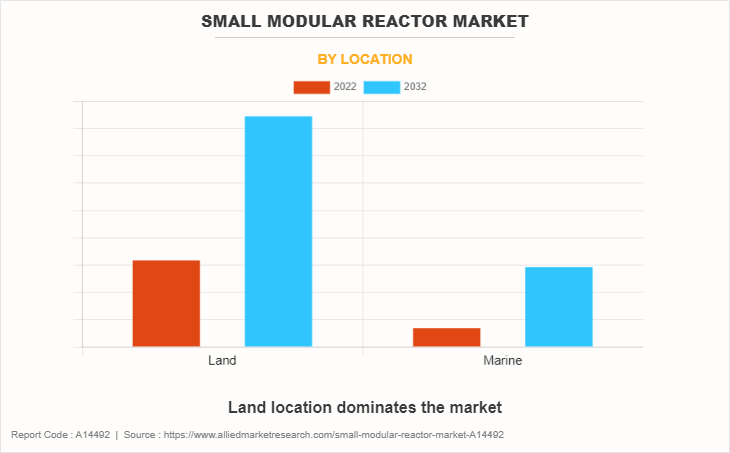
Based on the location, land held the highest small modular reactor market share in 2022, accounting for nearly three-fourths of the global market revenue, and are estimated to maintain their leadership status throughout the forecast period.
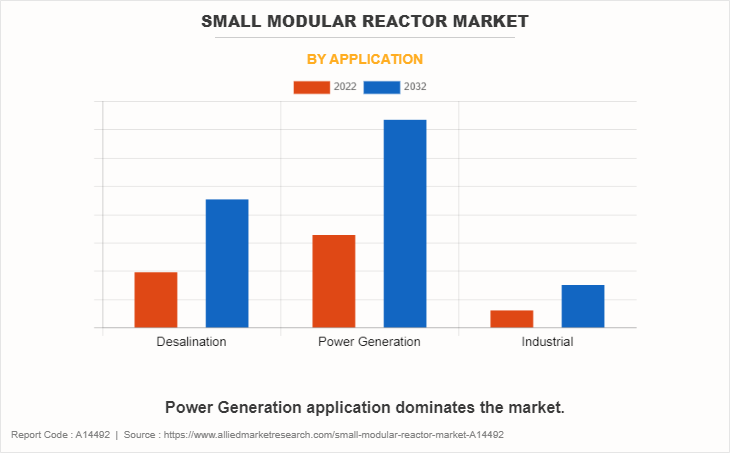
Based on the application, power generation held the highest market share in 2022, accounting for nearly three-fifths of the global small modular reactor market revenue, and are estimated to maintain their leadership status throughout the forecast period.
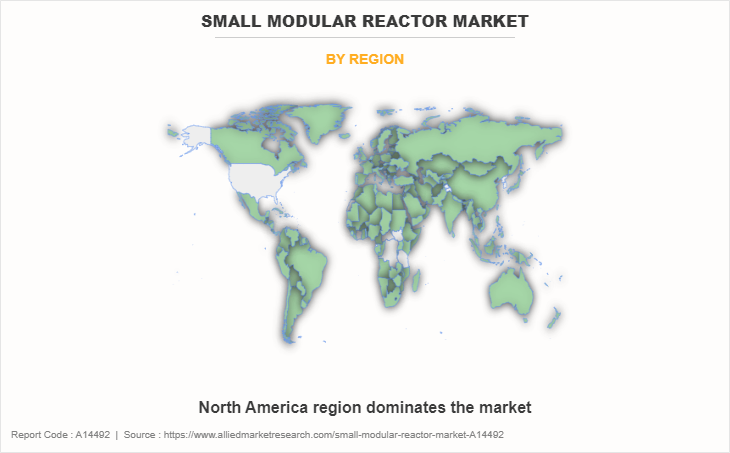
Based on region, North America held the highest market share in terms of revenue in 2022, accounting for nearly half of the global small modular reactor market revenue, and is likely to dominate the market during the forecast period. However, the Asia-Pacific region is expected to witness the fastest growing from 2023 to 2032. Modular reactors are being developed and deployed in Asia-Pacific countries to meet growing energy needs and nuclear capabilities.
Key players engaged in the small modular reactor market include Brookfield, Fluor Corporation, General Atomics, General Electric, Holtec International, Mitsubishi Heavy Industries, Rolls Royce Plc, TerraPower LLC, Terrestrial Energy, Ultra Safe Nuclear, Moltex Energy, NuScale Power LLC, Westinghouse Electric Company, and X Energy LLC. Agreement was the key strategy adopted by players such as Rolls Royce and General Electric.
Key Benefits For Stakeholders
- This report provides a quantitative analysis of the market segments, current trends, estimations, and dynamics of the small modular reactor market analysis from 2022 to 2032 to identify the prevailing small modular reactor market opportunities.
- The market research is offered along with information related to key drivers, restraints, and opportunities.
- Porter's five forces analysis highlights the potency of buyers and suppliers to enable stakeholders make profit-oriented business decisions and strengthen their supplier-buyer network.
- In-depth analysis of the small modular reactor market segmentation assists to determine the prevailing market opportunities.
- Major countries in each region are mapped according to their revenue contribution to the global market.
- Market player positioning facilitates benchmarking and provides a clear understanding of the present position of the market players.
- The report includes the analysis of the regional as well as global small modular reactor market trends, key players, market segments, application areas, and market growth strategies.
Small Modular Reactor Market Report Highlights
| Aspects | Details |
| Market Size By 2032 | USD 13.4 billion |
| Growth Rate | CAGR of 8.7% |
| Forecast period | 2022 - 2032 |
| Report Pages | 424 |
| By Reactor type |
|
| By Connectivity |
|
| By Deployment |
|
| By Power Rating |
|
| By Location |
|
| By Application |
|
| By Region |
|
| Key Market Players | Mitsubishi Heavy Industries Ltd., TerraPower, LLC., NuScale Power, LLC., Rolls-Royce plc., Brookfield Asset Management, Holtec International, Fluor Corporation, Terrestrial Energy Inc., Moltex Energy, X Energy LLC, General Atomics Corporation, Westinghouse Electric Company LLC., ULTRA SAFE NUCLEAR, General Electric Company |
Analyst Review
Industry leaders and Chief Executive Officers (CXOs) are navigating a landscape characterized by transformative potential and significant growth. The small modular market reactor market is currently at the forefront of a paradigm shift, driven by a confluence of factors that underscore the pivotal role these advanced nuclear technologies play in meeting global energy demands efficiently and sustainably.
The versatility of SMRs extends beyond traditional power generation, with applications ranging from remote and off-grid locations to industrial processes and desalination. This adaptability positions SMRs as a cornerstone in the global effort to transition towards a low-carbon future, providing a reliable and resilient energy source with reduced environmental impact. Furthermore, the small modular reactor market is witnessing increased attention due to its potential to address energy security concerns. The modular nature of these reactors ensures a distributed and decentralized energy infrastructure, mitigating risks associated with centralized power generation. This decentralization enhances the resilience of energy grids and contributes to a more secure and stable energy supply.
However, the small modular reactor market faces its own set of challenges. Regulatory frameworks, public perception, and financing hurdles are significant considerations that industry leaders must navigate. CXOs acknowledge the importance of fostering a collaborative ecosystem that includes regulators, policymakers, and the public to build confidence in the safety and efficacy of SMRs. In terms of investment, while the initial capital outlay for SMR projects is perceived as a challenge, the long-term benefits in terms of clean, reliable, and scalable energy production position them as a strategic investment for both governments and private entities. As technology advancements continue, costs are expected to decrease, making SMRs an attractive option for sustainable energy portfolios.
Power Generation is the leading application of small modular reactor market.
Innovative Designs, Regulatory Support, Modularity and Scalability, Partnerships and Collaborations, and Hybrid Energy Systems are the upcoming trends of Small Modular Reactor Market in the world.
North America is the largest regional market for small modular reactor market.
NuScale Power, Holtec International, TerraPower, Rolls-Royce plc, and GE Hitachi Nuclear Energy (GEH) are the top companies to hold the market share in small modular reactor market.
$13.4 billion is the estimated industry size of small modular reactor market in 2032.
Loading Table Of Content...
Loading Research Methodology...



